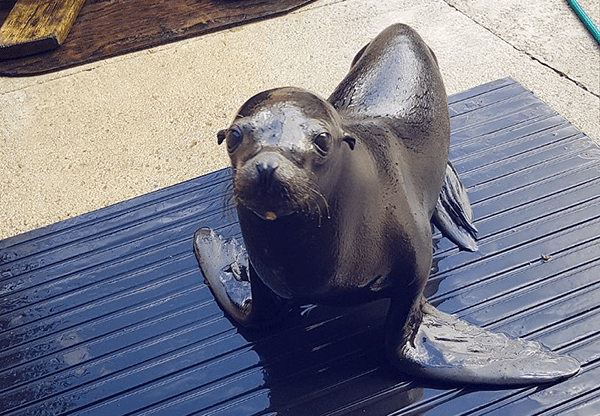New Arrival – Murphy The Sea Lion

We would like to introduce you to Murphy our 1 year old sea lion that has recently arrived from Belfast zoo in February. He joins our bachelor group which includes our big dominant male Clive as well as Merlin, Marvin and Miguel. Murphy is still getting used to his new surrounding but has been introduced to the rest of the group, over the past few weeks. He can be seen occasionally after shows and in the pool but he is just a bit too young to take centre stage just yet!
The sea lion show at Flamingo Land is one of our most popular attractions. It gives visitors a chance to learn about sea lions as a species and individually. They are trained and cared for by our dedicated team. Training an animal is a skill which is beneficial to both the animal and keeper. It is not something done purely for human entertainment by providing shows, but it can also be used to check the animal’s health, welfare and build the trust between the animal and its keeper. The training of the animals in this way provides physical and mental stimulation for the animal and helps to promote natural behaviours it may express in the wild. For example, balancing a ball on a sea lion’s nose requires it to feel the weight and direction of the ball through its whiskers. The sea lion would use similar behaviours in the wild when detecting the location of fish by feeling the ripples travelling through the water. The photo shows the sea lion jumping out of the pool to touch the ball with its nose. This requires a lot of strength and power from the sea lion, hence providing a form of exercise and physical stimulation.
California sea lions are found on the western coast of North America. Due to the large stretch of coastline they can be found in a variety of habitats and weather conditions. They would spend their time either swimming or hunting in the water, or on land on sandy beaches or rocks, particularly in the breeding season. They would hunt a mixture of seafood, but predominantly fish and squid. Because they are mammals, the sea lions have to hold their breath for their dives which last around 3 to 9 minutes. Whilst swimming in the water they would have to be alert for any predatory sharks or killer whales.
The California sea lion is related to seals and walrus and there are five species of sea lion in total. Adult females and males differ in appearance as males grow to be a lot larger than the females, some also have a large amount of fur around their neck – similar to a lion’s mane, hence the name sea ‘lion’. Males would try to attract several females within his territory, however the females are free to roam around to different territories. Sea lions can be very noisy and have a wide range of vocalisations. The average life span of a sea lion in the wild would be around 15 to 24 years, however in captivity they can live for a lot longer due to veterinary treatment, the absence of predators and due to them not needing to hunt for their food.


